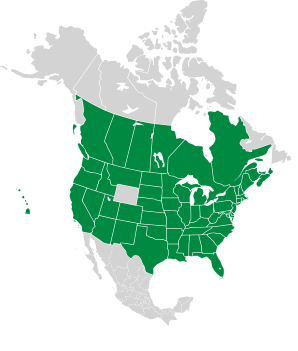Datura stramonium L. var. tatula (L.) Torr.
Datura tatula L.

|
Datura stramonium L. Jimson weed, devil’s trumpet, devil's weed, thorn apple, tolguacha, Jamestown weed, stinkweed, locoweed, datura, pricklyburr, devil’s cucumber, hell’s bells, moonflower, Jimsonweed
|
Flowers are trumpet-shaped when fully opened, but often look more like this. |
||||||||||||||||||||||||||||
|
Datura stramonium has many faces. It's a weed! It's a poison! It's a medicine! It's a recreational drug! It's a pretty flower! It's a munitions dump purifier! "Loco weed" refers to this species' ability to induce delirium and hallucinations in people, but there are unrelated plants also called locoweeds, including members of Oxytropis and Astralagus in North America, that are toxic to animals. Sources differ as to whether jimsonweed is native to North America or imported from the Old World. "Jimsonweed" is a corruption of "Jamestown weed"—read on to find out what happened to a group of Jamestown settlers who sampled the plant. Identification: This non-woody bush grows to 3-5′ (91-152 cm) in height, with stiff, hollow stems that are green or purple. Toothed, wrinkly leaves are 3-8″ (7.6-20 cm) × 1-6″ (2.5-15 cm). Flowers are large, attractive, trumpet-shaped, and pleasant-smelling, though the plant is malodorous. Flowers are 2½-3½″ (6.3-8.9 cm) long, white, cream-colored, purple, or white with a purple center. They usually open only partially, unfurling to produce a spiral, pinwheel-like effect. Fruits are a densely thorny egg-shaped capsule 1″ (2.5 cm) in diameter, consisting of four segments, and containing many dark brown or black seeds. Edibility: Poisonous Medical: Toxic plants, by virtue of the fact that they effect the body at all, can often be adapted for medicinal purposes, and this species is no exception. Medications derived from its several active ingredients can treat cholinergenic overdose, urinary tract infections, premenstrual syndrome, heart ailments, and dilate your eyes at eye exams. Historically, scopolamine was used to "treat" pregnant women during labor. It wasn't much help, but the short term amnesia it created erased memories of the pain. |
Jimsonweed is sometimes used as a recreational drug, but the potency varies and the threshold between a safe dose and a lethal dose is unpredictable. It is often described as a deliriant rather than a hallucinogen, since it induces very unpredictable behavior. In anthropologist Carlos Castaneda's books, the first of which is The Teachings of Don Juan: A Yaqui Way of Knowledge, he describes his experiences with this drug, given to him by a Yaqui Indian shaman. Here is an account by Robert Beverly of Jamestown settlers' experiences, from The History and Present State of Virginia, in Four Parts:
|
||||||||||||||||||||||||||||
|
These varieties of Datura have similar ranges and psychoactive effects, and they are often confused: | |||||||||||||||||||||||||||||
| You are here Datura stramonium |
Datura wrightii |
||||||||||||||||||||||||||||
|---|---|---|---|---|---|---|---|---|---|---|---|---|---|---|---|---|---|---|---|---|---|---|---|---|---|---|---|---|---|
| Common Name |  |
 |
|||||||||||||||||||||||||||
| Plant | This non-woody bush grows to 3-5′ (91-152 cm) in height, with stiff, hollow stems that are green or purple. Plant is malodorous. | Angel's trumpet grows in bushes 2-4′ (60-121 cm) high, with grayish-green stems coated with fine hairs. | |||||||||||||||||||||||||||
| Flowers | Flowers are smaller, 2½-5″ (6.3-12 cm) × 1-2″ (2.5-5 cm), trumpet-shaped, fragrant, white, cream-colored, purple, or white with a purple center. They usually open only partially, unfurling to produce a spiral, pinwheel-like effect. | Large, 5-9″ (12-22 cm) long, fragrant, trumpet-shaped, and white, cream-colored, or purplish. They have several segments, with small points at the edges between them. | |||||||||||||||||||||||||||
| Leaves | Toothed, wrinkly leaves are 3-8″ (7.6-20 cm) × 1-6″ (2.5-15 cm), mostly hairless. | Alternate, 6″ (15 cm) × 4″ (10 cm), with smooth margins and sometimes slightly wavy edges. The leaves have the unusual property that they are not symmetric at the base— one side is somewhat larger than the other. Leaf undersides have fine hairs. | |||||||||||||||||||||||||||
| Fruit | Densely thorny egg-shaped capsule 1″ (2.5 cm) in diameter, consisting of four segments, and containing many dark brown or black seeds. | Prickly, about 1″ (2.5 cm) across. | |||||||||||||||||||||||||||
| Range/ Zones |
|
|
|||||||||||||||||||||||||||
| Habitats | Coastal sage scrub, valley grasslands, joshua tree woods, pinyon-juniper woods | ||||||||||||||||||||||||||||
| Type | Wild | Wild | |||||||||||||||||||||||||||
Explosive Clearing Agent: If your yard should happen to be filled with leftover TNT (yes, the explosive, 2,4,6-trinitrotoluene), you'll be pleased to know that this species has a unique talent for clearing it, by converting it into harmless by-products.
References:
Online References:
Kansas Wildflowers and Grasses
The Virginia Tech Weed Identification Guide
SEINet—the Southwest Environmental Information Network
Datura stramonium L. var. tatula (L.) Torr.
Datura tatula L.
Datura stramonium description by Thomas H. Kent, last updated 16 Sep 2020.
© FloraFinder.org. All rights reserved.
8/10/1995 · King George County, Virginia · By Tim Chandler ![]() ID is uncertain
ID is uncertain 
Range:
